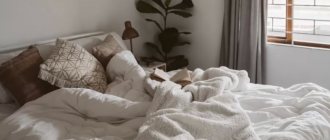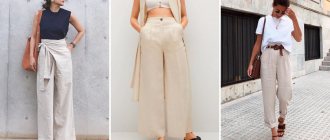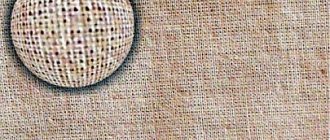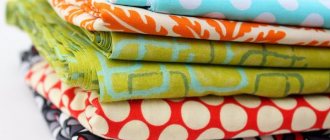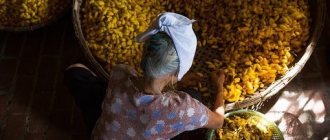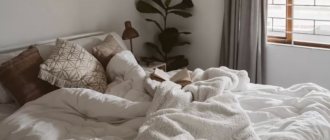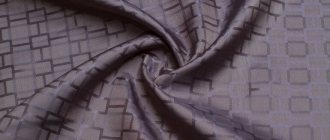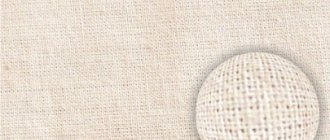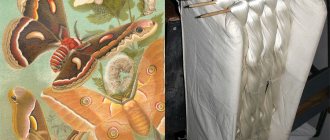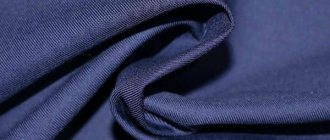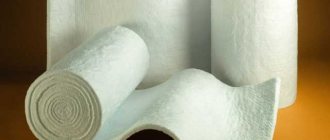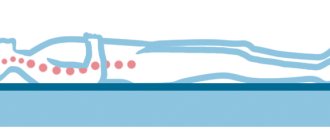Biomatin is an improved cotton fabric that is a direct analogue of knit. It is made from natural fibers, and a special biological impregnation is added during the production process. This improves the texture, makes the material hypoallergenic, completely safe for health and pleasant to the touch. Most often, biomatin is used to create bed linen and fabric household items. They note high wear resistance combined with a beautiful appearance that remains even after repeated washing.
Advantages and disadvantages
pros
Products made from biomatin have a number of good properties:
- Softness – the fabric is pleasant to the touch, which allows you to use it without any inconvenience;
- strength - the fabrics are made using a high-density weaving technique, which makes it possible to use the products for a very long time;
- thermoregulation - in winter the fabric retains heat and prevents freezing, and in summer it cools and promotes air circulation;
- wear resistance - a property primarily related to the color and pattern applied to the fabric, which during washing and other manipulations remains the same as before;
- hypoallergenic - the fabric does not cause allergic reactions, which allows people suffering from redness and other manifestations of allergies to use the product comfortably.
Minuses
There is only one minus:
- The fabric wrinkles quickly - which does not affect ease of use, but does affect the aesthetic appearance.
We take proper care
Read about: wet silk fabric: a brilliant embodiment of luxury.
This material is so versatile that it does not require the use of anything special in care. For long-term trouble-free use of bed linen, it is enough to know some general rules.
- For the first wash, select a cool temperature. Water will simply wash away the factory dust that has settled on the canvas during manufacturing or packaging.
- In the future, we continue to wash colored laundry at 40°C, and for light laundry it is possible to raise the temperature to 60-90°C.
- When machine washing and drying, it is recommended to use delicate cycles.
- We turn the products inside out.
- We wash different fabrics separately.
Unfortunately, allergies are considered one of the most common diseases of the 21st century. Its symptoms appear unexpectedly and at any age. Therefore, the introduction of new hypoallergenic fabric to the market is extremely important. Biomatin bedding can challenge this disease and provide healthy and sound sleep for adults and children.
© 2021 textiletrend.ru
Photo
Photo No. 1 Biomatin fabric (Packaging of TM Unison bed linen set)
Photo No. 2 Biomatin fabric (CPB 50 shades of gray)
Photo No. 3 Biomatin fabric (CPB Just Cavalli from Denis Simachev)
Photo No. 4 Biomatin fabric (bed linen)
Photo No. 5 Biomatin fabric (bed linen with guipure)
Photo No. 6 Biomatin fabric (bed linen)
Photo No. 7 Biomatin fabric (bed linen)
Biomatin fabric (bed linen)
Photo No. 9 Biomatin fabric (insert in TM Unison sets)
What are they sewing with this fabric?
Read about: mako-satin is a fabric that captivates with its luxury.
Biomatin, amazing in its properties, is today used only for sewing bed linen. The sets are characterized by gentle and airy tones that literally create magic and turn the bedroom interior into a romantic fairy tale. Designer collections reflect modern fashion trends in the use of natural colors, Russian motifs, or youth and sports themes for teenagers.
Let's look at prices and sizes
Biomatin in Russia is produced under the Unison trademark. The company produces 1.5 and 2-bed bedding for adults and children. The set includes a duvet cover, a sheet and one or two pillowcases.
| Kits | Dimensions, cm | Price in rubles |
| 1.5 bedroom (children) Duvet cover Sheet Pillowcase | 143x215150x214 70x70 – 1 pc. | From 1065 to 1482 |
| 1.5 sleeping (adult) Duvet cover Sheet Pillowcase | 145x215150x214 70x70 – 2 pcs. | 1620 |
| 2-bed Duvet Cover Sheet Pillowcase | 215x175 214x22070x70 – 2 pcs. | 1980 |
Percale, satin, poplin or calico: which is better?
High-quality textiles can add a unique flavor to the bedroom. Beautiful sheets on the bed, soft bedspreads and pillows of various shades will create a unique and cozy atmosphere.
Bed linen can be made of different materials. The most popular are calico, percale, satin, polysatin and poplin. Each of these materials has certain advantages and disadvantages. If we analyze all the pros and cons, we can conclude which fabric will be of higher quality, wear-resistant, and visually and financially attractive.
Many housewives wonder which fabrics are of better quality: poplin or satin, which is better for bed linen. Comparing these materials, we can conclude that products made from satin are more expensive. As for density, poplin is slightly denser and more velvety. Poplin also differs from satin in its silkiness. Moreover, both materials have a smooth surface.
Note! In terms of practicality and wear resistance, poplin can be compared to dense calico, but in terms of thinness and softness, the material is absolutely not inferior to satin.
As mentioned earlier, satin is considered the most expensive, followed by percale, but bedding sets made of calico and poplin will cost less.
Bedding made from percale looks rich, but the main difference between this material is the possibility of an allergic reaction to it, which is why many refuse to purchase it.
Percale bed linen
Note! As for naturalness, all of the listed materials are environmentally friendly, natural cotton.
Poplin and satin are the easiest to care for, since dirt from these materials is washed off at low temperatures. Linen made from them does not require careful ironing. Based on the ratio of the cost of the fabric and its appearance, poplin is considered the best option.
Satin set
Customer Reviews
Reviews about what kind of biomatin fabric this is are already waiting for you below - evaluate the unbiased opinion of buyers and share your experience if you have managed to purchase and test a set of underwear!
1. The linen is great - the print is of high quality, so soft and silky. We have been using it for a year now, after washing it does not fade or fade - we use it both for ourselves and for the nursery. I highly recommend purchasing!
2. The fabric really meets the stated characteristics - durable and dense, but soft and of very high quality. Looks incredibly expensive and decorates the bedroom!
Differences between cotton and other fabrics
- Combustion.
- All natural materials burn. Mixed ones burn with the formation of a larger or smaller drop of resin. Synthetic fabrics are melted.
- Cotton burns well, giving off a burnt paper smell. At the end of the combustion it smolders.
- Flax also burns well, but smolders much worse.
- Wool burns without smoldering, emitting a specific smell of burnt hair.
- Tactile and visual impressions.
- When touched, cotton feels like a warm, soft, easily wrinkled fabric. It drapes well.
- Linen is shiny, hard, cool, smooth. It drapes poorly and wrinkles very easily.
- Silk is a pleasant, soft, flexible, lightweight material. Doesn't wrinkle.
Cotton fabrics are hygienic, practical, and beautiful. From a wide range of products, you can always choose a comfortable, durable material that meets the needs and aesthetic requests of the buyer. Prices for many types of cotton fabrics are in the range accessible to the mass buyer.
Production of cotton fabrics:
textile.life
Product care
It’s worth talking in more detail about caring for products made from this material. If you follow a simple algorithm, you can extend the “life” of your favorite set - it will delight you for many years.
- Machine washable - 600-800 rpm is enough;
- The optimal temperature for colored clothes is 40C; if you wash white laundry, you can set it to 60C;
- Turn on the delicate mode and be sure to turn the products inside out;
- Use any powder or liquid gel - there are no strict restrictions. The main thing: exclude bleaches;
- Spinning is allowed, dry flat on a line or dryer in a ventilated area;
- You can iron - set the temperature to medium.
As a rule, all care requirements are indicated on the packaging of bed linen.
Additionally: clothing size 26 - how tall is the child?
Care instructions
Biomatin is an easy-to-use fabric that does not require special care. Bed linen is highly wear-resistant, but to extend the life of the product, it is recommended to follow simple rules:
- automatic washing is possible at temperatures up to 40 oC for colored sets, up to 90 oC for white ones;
- Before starting the washing machine, it is recommended to turn the laundry inside out - this reduces the risk of color loss;
- Fabrics of different textures and composition should be washed separately;
- drying is recommended naturally, away from sunlight;
Ironing can be carried out in the standard mode for cotton.
The packaging with bed linen always indicates the optimal modes and temperatures for effective washing. Some models have a tag inside the duvet cover.
Raw materials for producing cotton fabrics, methods of its processing
For the production of textile materials, cotton with fibers of different lengths is used.
- Short-staple cotton with a fiber length of up to 26 mm is little used on an industrial scale.
- Medium-fiber cotton is in demand. It grows in large quantities in Central Asia. The plant is productive, matures 140 days after sowing, and produces fibers with a maximum length of 35 mm.
- Long staple cotton is the preferred source of raw material. It has lower yields and requires special climatic conditions. The fiber length of such a plant reaches 45 mm. Grows in India, Pakistan, Turkey, Egypt, China, Mexico.
Marvelous! The cotton flower only lives for one day. Then the petals fall off and the formation of a seed box begins.
To propagate seeds, nature intended the presence of fluffy fibers on them, which will be easily carried by the wind over long distances. Man has found practical applications for these formations.
The resulting fibers differ in degree of maturity. Fully formed cotton is characterized by high strength, elasticity, absorbency, and dyeability. It contains up to 97% cellulose, which has about 6 thousand monomer units.
The intermediate stage preceding the production of fabrics is the transformation of fibers into yarn and threads. There are several spinning technologies. For cotton materials the following are used: carded, combed and machine spinning.
- Card spinning, which is the most common method, processes medium-staple cotton.
- Cotton with fine fibers is combed.
- Using the hardware method, low-grade fibers and waste resulting from the implementation of the first two spinning technologies are processed.
The threads used to produce cotton fabrics are either uniform or complex. They also differ in the presence or absence of torsion and the degree of its intensity.
History of the creation of biomatin
Modern scientists agree that bed linen was born back in the 4th century BC, and its homeland is Ancient Rome. Then the Romans regained their strength on mattresses made from sheep's wool.
In European countries of the Middle Ages, people slept on snow-white sheets made from natural fabrics, mainly linen and silk. Later, the names of their owners began to be printed on bed linen.
In the 16th century, bed linen with colored patterns came into fashion. Its producers for certain holidays. Most often, these were religious dates.
In Russia, lace bed linen has gained wide popularity. Emperor Peter the Great even brought the best craftswomen from Finland who taught this needlework to Russian women. This led to the fact that bed linen with lace, produced in the Oryol province, began to enjoy worldwide popularity. For example, it was successfully sold to England and France.
However, fashion is quite capricious. With the development of textile production, preferences for bed linen have also changed. The assortment began to be replenished with new fabrics. Biomatin was no exception.
It is noteworthy that this fabric was invented not so long ago in Russia. The unique material became known throughout the world thanks to.
Currently, biomatina is used as high-quality bed linen. Modern biomatin technical characteristics resemble silk, and the surface of the fabric is as smooth as satin. Bed linen made from biomat is in great demand due to its special comfort. In hot weather, the sheets provide coolness and do not stick to the body, and in the cold season, the product perfectly retains heat and maintains the temperature of the human body.
In addition, today single, one-and-a-half and double sets are produced from fabric. Since this material is hypoallergenic, special children's bedding is also made from it, which is in particular demand among buyers. On store shelves there is a wide range of textiles for every taste and color. Biomatin lends itself perfectly to applying any images and inscriptions.
Classification by purpose of fabrics made from cotton raw materials
- Demi-season fabrics are made from carded and combed single-strand twisted yarn. The high density of the material provides thermal protection and the ability to retain shape. This group includes weighted garus with plain weave, all varieties of tartan, as well as fabric with crepe or finely patterned weave, which is called wool. In the group of demi-season materials, a large volume is occupied by shirt fabrics, which include poplin, reps, taffeta, and satins. Demi-season dress fabrics are varied in manufacturing methods and finishing methods.
- Summer fabrics are light, low density, and highly breathable. Lightweight materials for general use include voile, cambric, and volta.
- Winter materials have maximum density, brushed pile. These include flannel and flannel.
- A separate group consists of clothing fabrics, from which mainly industrial clothing is sewn. To increase strength, nylon fiber is added to cotton.
- Lining fabrics are an auxiliary material in sewing. These include calico, side and pocket fabric.
- Decorative materials for furniture are used for upholstery, drapery, sewing drapes and curtains. The canvases have great strength, resistance to stretching and abrasion.
- The group of piece products includes handkerchiefs and headscarves. They are made from pure cotton or with the addition of viscose. The types of weaves used are plain, twill.
- Cotton fabrics are used to produce lightweight and flannelette blankets. The fabrics of some types of blankets additionally contain threads of nylon, viscose or lavsan.
Cotton fabrics are a large group of diverse products that differ in basic manufacturing methods and modifications of known technologies.
